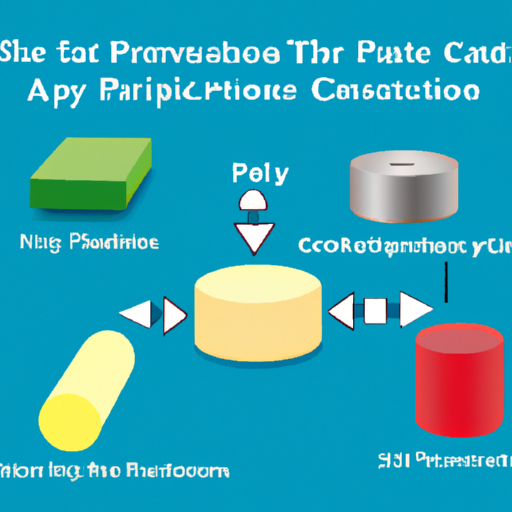

Polymer capacitors are a type of capacitor that uses a conductive polymer as the electrolyte instead of a liquid or gel electrolyte. This type of capacitor offers several advantages over traditional electrolytic capacitors, including lower ESR (Equivalent Series Resistance), longer lifespan, and better stability over a wide range of temperatures. In this article, we will explore the common production processes for polymer capacitors.

2. Electrode Formation: Once the conductive polymer has been synthesized, the next step is to form the electrodes of the capacitor. The electrodes are typically made of a metal such as aluminum or tantalum, which is coated with a thin layer of the conductive polymer. This coating is applied through a process called electrodeposition, where the metal electrode is immersed in a solution of the conductive polymer and an electric current is passed through the solution to deposit the polymer onto the electrode.
3. Dielectric Formation: The dielectric of a polymer capacitor is typically a thin layer of aluminum oxide, which is formed through a process called anodization. In this process, the aluminum electrode is immersed in an electrolyte solution and an electric current is passed through the solution to form a layer of aluminum oxide on the surface of the electrode. This aluminum oxide layer acts as the dielectric of the capacitor, providing insulation between the electrodes.
4. Assembly: Once the electrodes and dielectric have been formed, the next step is to assemble the capacitor. The electrodes are typically stacked on top of each other, with the dielectric layer sandwiched between them. The electrodes are then connected to the external leads of the capacitor, which are typically made of a conductive material such as copper or silver. The entire assembly is then encapsulated in a polymer casing to protect the capacitor from external elements.
5. Testing and Quality Control: After the capacitor has been assembled, it undergoes rigorous testing to ensure that it meets the required specifications. This testing typically involves measuring the capacitance, ESR, and leakage current of the capacitor to ensure that it meets the desired performance characteristics. The capacitor is also subjected to environmental testing, such as temperature cycling and humidity testing, to ensure that it can withstand harsh operating conditions.
6. Packaging and Labeling: Once the capacitor has passed all the required tests, it is packaged and labeled for shipment to customers. The packaging typically includes information such as the capacitance value, voltage rating, and temperature rating of the capacitor. The capacitor is then shipped to customers for use in various electronic devices, such as power supplies, inverters, and motor drives.
In conclusion, the production of polymer capacitors involves several key processes, including polymer synthesis, electrode formation, dielectric formation, assembly, testing, and packaging. These processes are critical to ensuring that the capacitor meets the required specifications and performance characteristics. Polymer capacitors offer several advantages over traditional electrolytic capacitors, making them a popular choice for a wide range of electronic applications.
Polymer capacitors are a type of capacitor that uses a conductive polymer as the electrolyte instead of a liquid or gel electrolyte. This type of capacitor offers several advantages over traditional electrolytic capacitors, including lower ESR (Equivalent Series Resistance), longer lifespan, and better stability over a wide range of temperatures. In this article, we will explore the common production processes for polymer capacitors.

2. Electrode Formation: Once the conductive polymer has been synthesized, the next step is to form the electrodes of the capacitor. The electrodes are typically made of a metal such as aluminum or tantalum, which is coated with a thin layer of the conductive polymer. This coating is applied through a process called electrodeposition, where the metal electrode is immersed in a solution of the conductive polymer and an electric current is passed through the solution to deposit the polymer onto the electrode.
3. Dielectric Formation: The dielectric of a polymer capacitor is typically a thin layer of aluminum oxide, which is formed through a process called anodization. In this process, the aluminum electrode is immersed in an electrolyte solution and an electric current is passed through the solution to form a layer of aluminum oxide on the surface of the electrode. This aluminum oxide layer acts as the dielectric of the capacitor, providing insulation between the electrodes.
4. Assembly: Once the electrodes and dielectric have been formed, the next step is to assemble the capacitor. The electrodes are typically stacked on top of each other, with the dielectric layer sandwiched between them. The electrodes are then connected to the external leads of the capacitor, which are typically made of a conductive material such as copper or silver. The entire assembly is then encapsulated in a polymer casing to protect the capacitor from external elements.
5. Testing and Quality Control: After the capacitor has been assembled, it undergoes rigorous testing to ensure that it meets the required specifications. This testing typically involves measuring the capacitance, ESR, and leakage current of the capacitor to ensure that it meets the desired performance characteristics. The capacitor is also subjected to environmental testing, such as temperature cycling and humidity testing, to ensure that it can withstand harsh operating conditions.
6. Packaging and Labeling: Once the capacitor has passed all the required tests, it is packaged and labeled for shipment to customers. The packaging typically includes information such as the capacitance value, voltage rating, and temperature rating of the capacitor. The capacitor is then shipped to customers for use in various electronic devices, such as power supplies, inverters, and motor drives.
In conclusion, the production of polymer capacitors involves several key processes, including polymer synthesis, electrode formation, dielectric formation, assembly, testing, and packaging. These processes are critical to ensuring that the capacitor meets the required specifications and performance characteristics. Polymer capacitors offer several advantages over traditional electrolytic capacitors, making them a popular choice for a wide range of electronic applications.